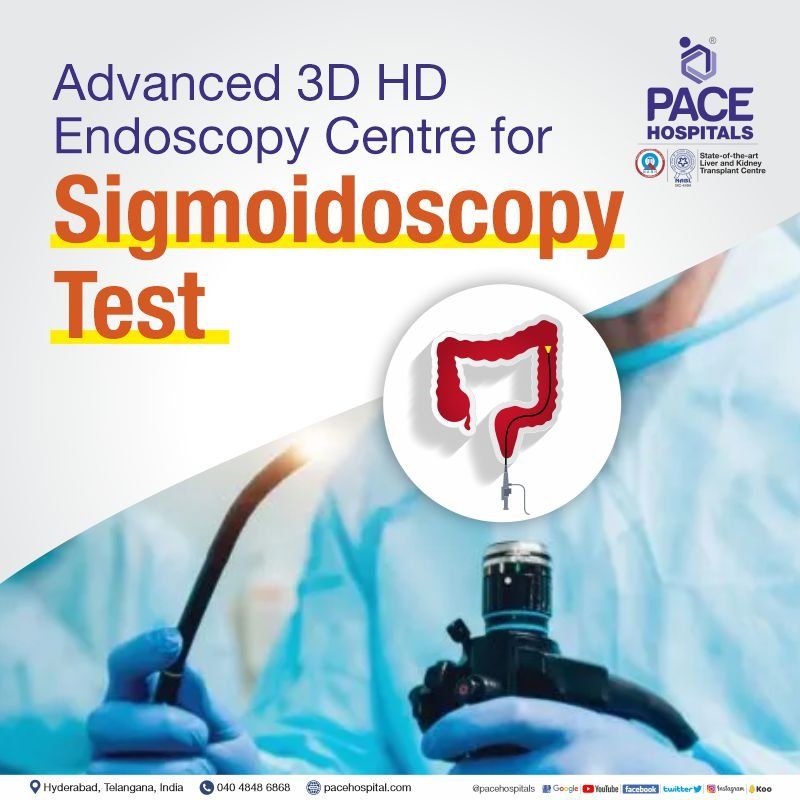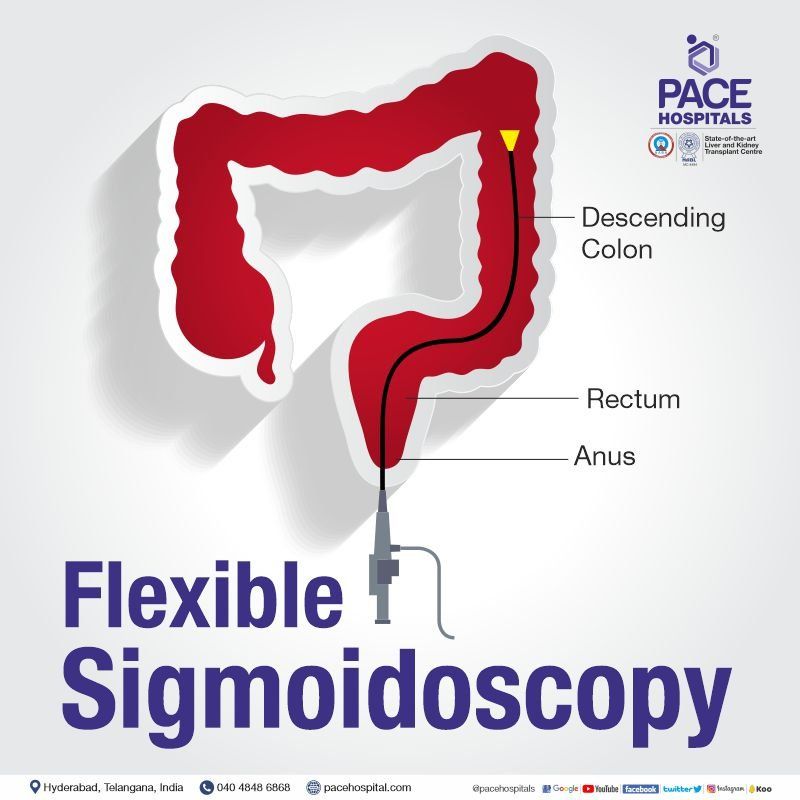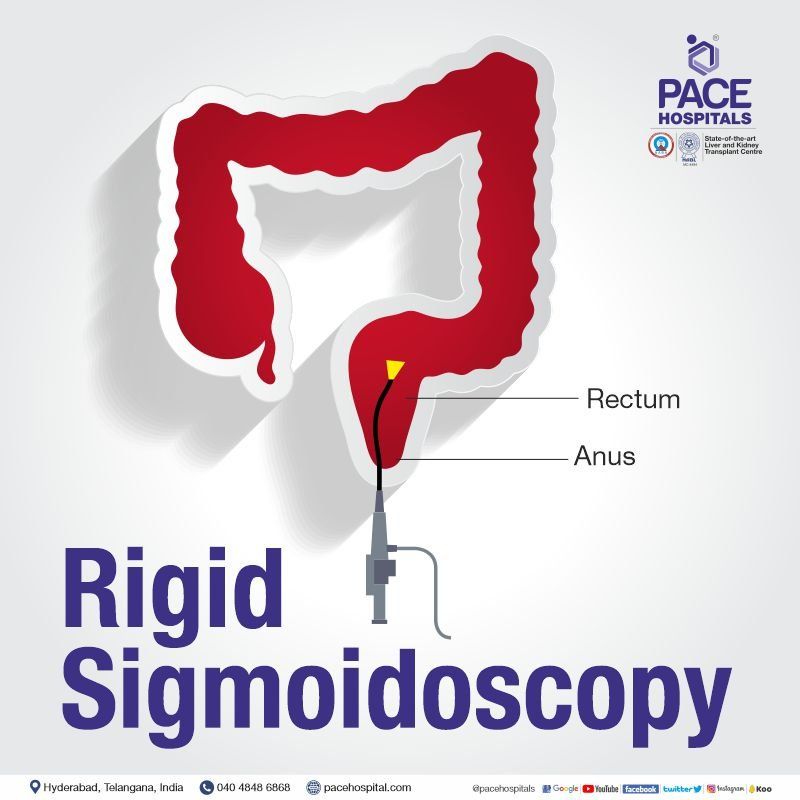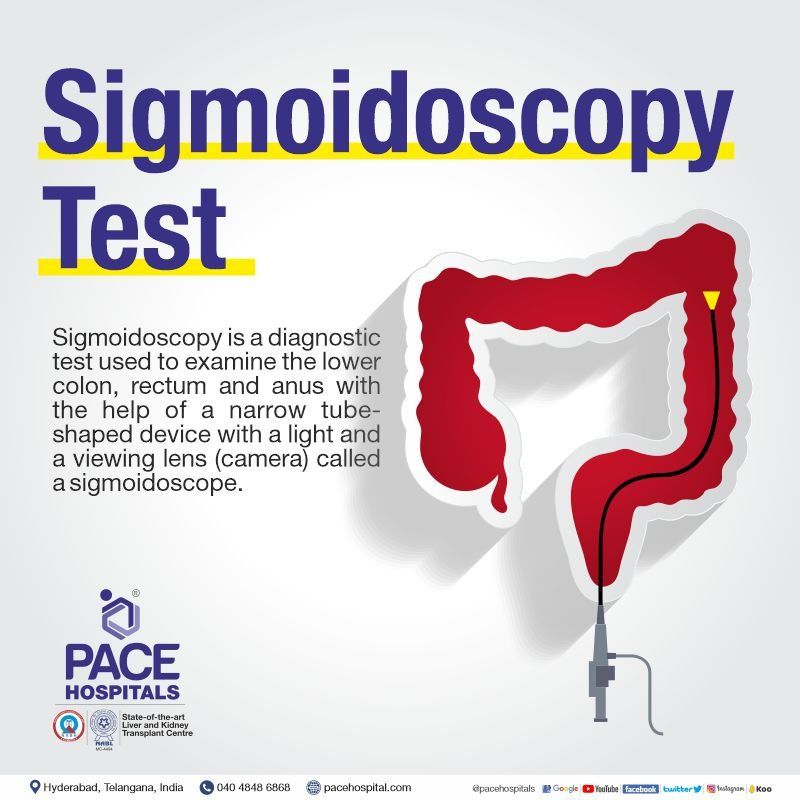Sigmoidoscopy Test – Procedure Indications, Purpose, Side Effects & Cost
At PACE Hospitals, our expert team of sigmoidoscopy specialists — including medical gastroenterologists, surgical gastroenterologists, and proctologists — are highly experienced in diagnosing and treating complex conditions. From inflammatory bowel diseases such as ulcerative colitis and Crohn’s disease to diverticula, hemorrhoids, piles, strictures, ulcers, colon and rectal cancers, intestinal and colon polyps, our doctors deliver precise care using an advanced endoscopic suite. With a patient-centric approach, we ensure accurate diagnosis and minimally invasive treatments tailored to every individual’s needs.
Request an appointment for Sigmoidoscopy Test
Sigmoidoscopy test - appointment
Why choose PACE Hospitals for sigmoidoscopy test?

20,000+ Sigmoidoscopy Test Performed
Advanced 3D HD Endoscopy Unit
Team of the Best Sigmoidoscopy Doctors
All insurance and TPAs accepted
What is a Sigmoidoscopy and its purpose?
Sigmoidoscopy meaning
Sigmoidoscopy procedure is a diagnostic test used to examine the lower colon (descending colon), rectum and anus with the help of a narrow tube-shaped device with a light and a viewing lens (camera) called a sigmoidoscope. It might consist of a tool to remove tissue for microscopic examination (biopsy) of disease.
Sigmoidoscopy test is one of the most common methods used to examine the signs and symptoms of gastrointestinal diseases such as inflammatory bowel diseases (ulcerative colitis and Crohn’s disease), diverticula (pouches on the colon wall),
haemorrhoids or
piles, strictures, ulcers,
colon cancer, rectal cancer, intestinal polyps (abnormal tissue growth that may turn into cancer with time) and examine the signs and symptoms of any other intestinal diseases. It can be completed in around 15 to 30 minutes.
Types of Sigmoidoscopy
Based on the extent of the sigmoidoscope’s reach in the lower large intestine, there are mainly two types of sigmoidoscopy procedure –
- Flexible sigmoidoscopy
- Rigid sigmoidoscopy

Flexible sigmoidoscopy
It is a procedure used to examine the lower part of the large intestine (up to the descending colon). It is performed using a 60 cm thin flexible fibre optic tube (flexible sigmoidoscope).

Rigid sigmoidoscopy
It is also known as proctoscopy, a procedure used to examine the rectum and the anus. A hollow tube (rigid sigmoidoscope) used in this process with a length of 25 centimetres is ideally suited for rectal assessments only, as it reaches up to the rectum and sigmoid colon.
Comparison between Sigmoidoscopy, Proctoscopy, Colonoscopy and Endoscopy
Flexible Sigmoidoscopy vs Colonoscopy | Difference between Colonoscopy and Sigmoidoscopy
Both these procedures serve as screening tests for the detection of colorectal cancer. Depending on the patient’s need, extent or area of screening covered in the large intestine, the gastroenterologist recommends either of one.
| Elements | Colonoscopy | Sigmoidoscopy |
|---|---|---|
| Degree of invasiveness | More Invasive | Less invasive |
| Screening area | It screens the entire colon, rectum and anus for the presence of swollen, irritated tissues, polyps or cancer. | Only the lower part of the large intestine (descending colon, rectum, and anus). |
| Requirement of sedation | In most cases, sedation or anaesthesia is advised. | Anaesthesia or sedative is not required usually. |
| Duration | A colonoscopy may take anywhere from 30 minutes to an hour. However, additional time might be taken if any procedure has been done along with screening. | A sigmoidoscopy procedure can be completed in around 15 to 30 minutes. However, if there is any removal of polyps or biopsy, it might take additional time. |
| Frequency | As a prophylactic, once every 10 years* if the patient reaches the age of 50. Once every 5 years after 60. Based on the risk and benefit analysis, the physician may or may not suggest a colonoscopy scan once the patient is aged 75 to 80 years. | As a prophylactic, usually every 5 years, or every 10 years with an annual faecal occult blood test, starting at age 50. * For people who do not have an increased risk of colorectal cancer. |
Sigmoidoscopy vs Endoscopy | Difference between Sigmoidoscopy and Endoscopy
These are nonsurgical procedures used to examine the gastrointestinal tract for the presence of gastrointestinal abnormalities with the help of a thin flexible endoscope (a flexible tube with a light and lens).
| Elements | Sigmoidoscopy | Endoscopy |
|---|---|---|
| Screening area | Only the lower part of the large intestine (descending colon, rectum, and anus). | It examines the complete gastrointestinal tract starting from mouth to large intestine. |
| Investigate | To diagnose the symptoms like diarrhoea, abdominal pain, constipation, polyps (abnormal growths) and intestinal bleeding. To screen for presence of rectal and colorectal cancer. | The causative factor for digestive symptoms like heartburn, nausea, vomiting, abdominal pain, difficulty swallowing, and gastrointestinal bleeding. To screen for the presence of stomach cancer or gastric cancer. |
| Treatment | Treatment options include excision of an intestinal polyps or haemorrhoids. | Treatment options include dilatation of a narrow oesophagus, excision of an intestinal polyp, and cauterization of a bleeding blood vessel. |
| Requirement of sedation | Anaesthesia or sedative is not required usually. | Sedation or anaesthesia will be used, depending on the type of the operation. |
| Frequency | As a prophylactic, usually every 5 years, or every 10 years with a faecal occult blood test is performed annually, starting at age 50. | Endoscopy will be recommended by the gastroenterologist based on the patient's condition and needs. |
Frequently asked questions:
Can a sigmoidoscopy detect colon cancer?
Yes, flexible sigmoidoscopy is used to detect colon cancer. During the flexible sigmoidoscopy procedure, the gastroenterologist might observe colon polyps on the lining of the patient’s colon that has the potential to become cancerous.
Does a flexible sigmoidoscopy hurt?
In most cases, flexible sigmoidoscopy does not cause any pain. Without using any sedation or analgesia, the gastroenterologist will insert a flexible fibre optic tube into the patient's lower colon. During the procedure, the patient may experience bloating or cramping.
What is biopsy in flexible sigmoidoscopy test?
Yes, sigmoidoscopy can be used to take a colon biopsy. The sigmoidoscope is accompanied by a special brush, forceps, or swab which is used to collect the tissue sample from the lining of the patient’s rectal, sigmoid and descending colon (lower part of the large intestine) while the patient is being performed a sigmoidoscopy test.
Can polyps be removed during sigmoidoscopy?
Yes, polyps can be removed during sigmoidoscopy. The sigmoidoscope is accompanied by a special instrument, that is used to remove polyps present in the patient’s lower part of the large intestine when they are observed during the sigmoidoscopy test.
How much does a flexible sigmoidoscopy cost in Hyderabad?
Flexible sigmoidoscopy cost in Hyderabad ranges vary from Rs. 2,600 to Rs. 6,500 (two thousand six hundred to six thousand five hundred). However, cost of sigmoidoscopy test in hyderabad vary depending upon the multiple factors such as patient condition, diagnostics, insurance approval for cashless facility, corporate policy, CGHS, EHS, ESI etc.
How much does a flexible sigmoidoscopy test price in India?
Flexible sigmoidoscopy test price in India ranges vary from Rs. 2,200 to Rs. 8,500 (two thousand two hundred to eight thousand five hundred). However, sigmoidoscopy price in India vary may vary depending upon the different hospitals in different cities.







